
Murray Hunter
“Illegal” Hindu Temples: A crisis of governance and historical amnesia
P Ramasamy
Apr 23, 2025

MIC deputy president M. Saravanan raised a valid concern in urging Prime Minister Anwar Ibrahim to halt the trend of labelling Hindu temples as “illegal” simply because their locations are deemed contentious.
Similarly, Zaid Malek, director of Lawyers for Liberty, called on the government to stop using the term “illegal” when referring to Hindu temples situated on disputed land.
However, unlike Saravanan, Zaid went further, directly blaming the government and relevant authorities for the emergence of this controversy.
Zaid argued that the issue of so-called “illegal” temples would not have erupted if Anwar had not prematurely claimed success in relocating the 130-year-old Sri Dewi Pathrakaliamman temple in Kuala Lumpur to make way for the Masjid Madani. This action has triggered a dangerous narrative, leading even a hospital authority in Taiping to lodge a complaint over a nearby temple’s existence, branding it “illegal.”
It has become painfully clear that the recent relocation has opened the floodgates for Hindu temples—many of them over a century old—to be conveniently labelled as “illegal.”
The relocation of the Sri Dewi Pathrakaliamman temple stands as a turning point, and Anwar must take full responsibility for this decision, especially as it was facilitated by sycophants within MIC, DAP, and PKR.
By overseeing and endorsing the forced relocation, Anwar has significantly compromised his image as a leader for all Malaysians. Despite assurances of a new site for the temple, it was evident that Anwar sided with majoritarian religious and cultural interests, undermining the deep historical and spiritual significance of the temple.
The MIC, once the principal political voice of Malaysian Indians, publicly supported the relocation. However, private expressions of dissent within the party sharply contrasted with its public stance. MIC had a duty to manage temple-related issues more effectively. Had it demonstrated the political will, many so-called “illegal” temples could have been regularized over the years.
That said, the primary responsibility lies not with MIC but with the federal and state governments, and municipal authorities. These institutions failed to allocate land and recognize the heritage value of these temples, thereby allowing the “illegal” label to persist. The onus is on them to right this historical wrong.
Compounding the issue are certain self-proclaimed religious authorities from the majoritarian community who demonstrate a fundamental lack of understanding—or worse, deliberate ignorance—of the historical context behind Hindu temples in Malaysia. Many of these temples were established during the colonial era, long before the introduction of the Torrens System of land registration, Malaysia’s independence, the establishment of the Kuala Lumpur City Council, or the eventual sale of the land to entities like Jakel Trading.
The term “illegal,” when applied to these temples, is not rooted in legality but in narrow, divisive political and religious agendas. It is a label weaponized to delegitimize a community’s heritage and identity.
Tragically, the careless and politically charged use of the word “illegal” in reference to the Kuala Lumpur temple has now emboldened others to apply the same label elsewhere. Anwar may have initiated this crisis—intentionally or not—but the question remains: how does he intend to manage the growing fallout?
If left unaddressed, this issue risks spiraling into a national crisis of identity, governance, and religious harmony.
P. Ramasamy
Chairman Urimai
April 23, 2025
Holy Sites must be administered and made accessible by their own followers, not outsiders. But the 3000yo Holiest Kuil (Temple) of all is administered by outsiders; access is so restricted. there are 11 entrances but only one can be used by the kuil followers on certain days and hours only. If cannot masuk to pray they have to Bawl and Wail outside on the Western Wall. Kesian. Give Isaac his Kuil lah. Ishmael, you already have yours which nobody disputes or wants to Rampas. Why so tamak?
ReplyDeleteThe Wailing Wall is a memento of what happened when a group became too arrogant
DeleteHaram is Haram.
ReplyDeleteI distinguish between pre-existing religious structures that were built with the permission of the original
Landowner. These should not become "illegal" just because the ownership of the land change.The proper settlement of the structure must be part of the land transaction.
Unapproved Structures that sprout overnight on existing vacant land (no preexisting structure) ARE ILLEGAL , HARAM, and are properly subject to demolition.
P. Ramasamy and his ilk must not demand impunity for trespassing and pirating of private property.